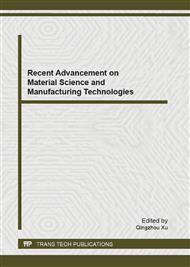p.328
p.332
p.337
p.342
p.346
p.350
p.357
p.363
p.367
Inductively Coupled Plasma Etching of Pt/Ti Electrodes in Cl-Based Plasma
Abstract:
Dry etching of Pt/Ti film was carried out using Cl2/Ar plasmas in an inductively coupled plasma (ICP) reactor. The influence of the various process parameters, such as RIE power, ICP power and Cl2/Ar gas mixing ratio, on the etch rate and selectivity of photoresist to Pt/Ti film were investigated systematically and optimized. It was revealed that the etch rate and the selectivity strongly depended on the key process parameters. The etch rate was found to increase dramatically with increasing of RIE power and ICP power. But by changing the ratio of Cl2 to the total gas, the maximum etch rate could be obtained at the proper ratio of 20%. The results also indicated too low or too high RIE power and the Cl2 ratio was detrimental to the selectivity. The optimized parameters of Pt/Ti dry etching for high etch rate and low selectivity of photoresist to Pt/Ti were obtained to be pressure: 10mT, RF power: 250W, ICP power: 0W, Cl2: 8sccm (standard cubic centimeters per minute), Ar: 32sccm.
Info:
Periodical:
Pages:
346-349
Citation:
Online since:
July 2013
Authors:
Keywords:
Price:
Сopyright:
© 2013 Trans Tech Publications Ltd. All Rights Reserved
Share:
Citation:


